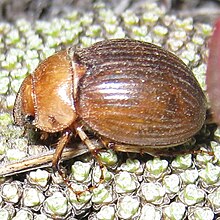Cromwell Chafer Beetle
| Prodontria lewisi | |
|---|---|
 |
|
| Scientific classification | |
| Kingdom: | Animalia |
| Phylum: | Arthropoda |
| Class: | Insecta |
| Order: | Coleoptera |
| Family: | Scarabaeidae |
| Genus: | Prodontria |
| Species: | P. lewisi |
| Binomial name | |
|
Prodontria lewisi Broun, 1904 |
|
|
|
Prodontria lewisi (the Cromwell chafer beetle) is a flightless beetle in the family Scarabaeidae. It is found in just one spot in Central Otago, New Zealand, which is now a beetle reserve.
This species was named by Broun in 1904 as Prodontria Lewisii, from "three mutilated individuals found by Mr. J. H. Lewis on the sand-hills of the Molyneaux River." Although its species epithet was lewisii, the modernised genitive of Lewis, it is often referred to as Prodontria lewisi.
This large beetle has pale reddish-brown elytra which are strongly convex and with deep groves passing along their length. Females are longer and wider than males, but males have a longer hind foot and tibia.
The beetles live underground. They spend at least one year as larvae, living buried in the sand and feeding on plant roots. Adults emerge on humid nights on spring and summer for a few hours to feed on lichens and plants – mostly speedwell (Veronica arvensis), sheep's sorrel (Rumex acetosella), and cushion plant (Raoulia australis) – and to mate. Males emerge slightly earlier in the year than females, on average.
The habitat of this beetle is an area of low sand dunes on the Cromwell river terrace, known as the “Cromwell shallow sand”. The dunes are formed by loess originally deposited by the Clutha River. As P. lewisi seems to be adapted to burrowing in these inland dunes, its entire natural range was probably never more than 500 hectares.
The species is currently restricted to an 81 hectare nature reserve, between Bannockburn and Cromwell. Regular surveys of the beetle suggest they are only using 12% of the habitat available in the reserve.
The river terrace the beetle occupies is also the location of the town of Cromwell. Some of the beetles were found north of the town in 1968, next to a nine-hole golf course, but that population was destroyed when the course was expanded to 18 holes. A block of undeveloped habitat surrounded by streets existed in the town of Cromwell itself by the 1970s; two residents used pitfall traps to catch and relocate the beetles from this block over 1975–76, before it was levelled for housing. Much of the rest of the beetle's original 500-hectare range was destroyed by the construction of the Clyde Dam in 1979 and the subsequent formation of Lake Dunstan.
...
Wikipedia

